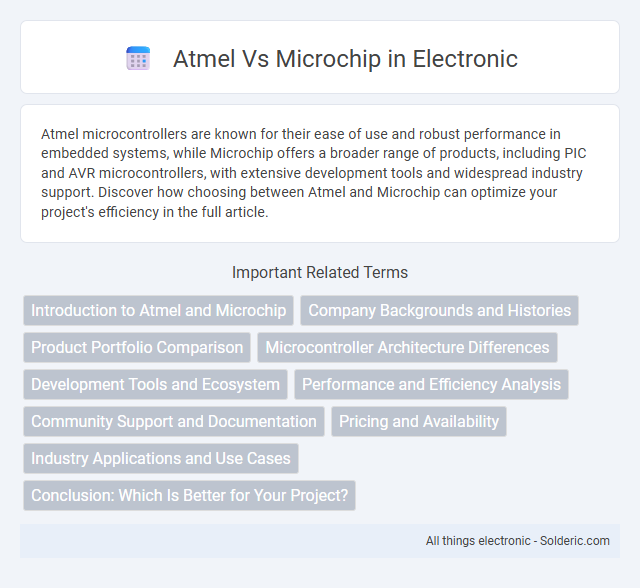Atmel microcontrollers are known for their ease of use and robust performance in embedded systems, while Microchip offers a broader range of products, including PIC and AVR microcontrollers, with extensive development tools and widespread industry support. Discover how choosing between Atmel and Microchip can optimize your project's efficiency in the full article.
Comparison Table
| Feature | Atmel | Microchip |
|---|---|---|
| Company Overview | Founded in 1984, specializes in microcontrollers and semiconductors. | Founded in 1989, global leader in microcontrollers and analog solutions. |
| Product Range | AVR, ARM Cortex-M based MCUs, touch controllers, sensors. | PIC, AVR, dsPIC, ARM Cortex-M MCUs, analog ICs, EEPROMs. |
| Microcontroller Families | AVR 8-bit, ARM Cortex-M0/M3/M4. | PIC 8/16/32-bit, AVR, ARM Cortex-M0/M3/M4/M7. |
| Development Tools | Atmel Studio, Atmel START, Atmel ICE debugger. | MPLAB X IDE, MPLAB Code Configurator, PICkit debuggers. |
| Acquisition | Acquired by Microchip Technology in 2016. | Current owner of Atmel brand and product lines. |
| Market Focus | Embedded systems, consumer electronics, automotive. | Industrial automation, automotive, consumer electronics, IoT. |
| Support & Community | Strong user community, legacy forum archives. | Extensive global support, online forums, training resources. |
Introduction to Atmel and Microchip
Atmel, founded in 1984, became a leading developer of microcontrollers and semiconductor solutions, especially known for its AVR microcontroller architecture widely used in embedded systems. Microchip Technology, established in 1989, is a global leader in microcontroller, analog, FPGA, and memory products, with the PIC microcontroller series as a flagship offering. Microchip acquired Atmel in 2016, combining Atmel's expertise in ARM-based solutions with Microchip's strong presence in the 8-bit and 16-bit microcontroller markets.
Company Backgrounds and Histories
Atmel, founded in 1984, gained recognition for its innovation in microcontroller and semiconductor technology before being acquired by Microchip Technology in 2016. Microchip Technology, established in 1989, is a leading provider of microcontroller, mixed-signal, analog, and Flash-IP solutions, known for its extensive product portfolio and global reach. The acquisition of Atmel allowed Microchip to expand its market share and integrate Atmel's advanced AVR and ARM-based microcontrollers into its offerings.
Product Portfolio Comparison
Atmel offers a diverse product portfolio including AVR microcontrollers, ARM-based MCUs, and programmable logic devices, catering to embedded system applications with a focus on ease of use and low power consumption. Microchip's extensive portfolio combines PIC microcontrollers, dsPIC digital signal controllers, and recently acquired Atmel's lineup, providing broad solutions for industrial, automotive, and consumer electronics markets. When selecting Your microcontroller supplier, consider Microchip's wider product range and ecosystem integration against Atmel's specialized legacy offerings.
Microcontroller Architecture Differences
Atmel microcontrollers typically use AVR and ARM Cortex-M architectures, offering efficient 8-bit and 32-bit processing solutions, while Microchip provides a broader range including PIC, dsPIC, and ARM Cortex-M cores optimized for diverse applications from simple control to digital signal processing. Microchip's PIC microcontrollers emphasize low power consumption and enhanced peripheral integration, whereas Atmel's AVR architecture delivers fast instruction execution and ease of programming. Understanding these architectural differences helps you select the optimal microcontroller for your embedded system requirements, balancing performance, power, and complexity.
Development Tools and Ecosystem
Microchip offers a comprehensive development ecosystem with MPLAB X IDE and a wide range of tools like MPLAB Code Configurator, which simplifies programming and debugging for their microcontrollers. Atmel, now part of Microchip, originally provided Atmel Studio, a robust IDE tailored for AVR and ARM Cortex-M devices, known for its user-friendly interface and extensive debugging capabilities. Your choice depends on whether you prefer Microchip's integrated, versatile environment or the legacy Atmel Studio's specialized support, both supported by vast community resources and third-party integrations.
Performance and Efficiency Analysis
Microchip microcontrollers generally offer higher performance with improved processing speeds and lower power consumption compared to legacy Atmel devices, which were known for ease of use and broad peripheral support. Your choice depends on application needs; Microchip's PIC and AVR MCUs exhibit enhanced efficiency in real-time processing and power-sensitive applications due to advanced architectures and optimized instruction sets. Benchmark analyses reveal Microchip's integration of extensive optimization techniques, delivering better throughput and energy efficiency critical for embedded system design.
Community Support and Documentation
Microchip offers extensive community support and comprehensive documentation, benefiting from Atmel's integration since its acquisition, which enriched its resource base with detailed application notes, tutorials, and active forums. The Atmel section within Microchip's ecosystem continues to provide in-depth datasheets and user guides specifically tailored for AVR and SAM microcontrollers, ensuring ample support for developers. Your projects gain reliability through access to a robust network of experienced users and official materials that accelerate troubleshooting and innovation.
Pricing and Availability
Microchip generally offers more competitive pricing due to wider production scale and extensive product availability compared to Atmel, which was acquired by Microchip in 2016. Microchip's distribution network ensures global availability of its microcontrollers and integrated circuits, often leading to reduced lead times and lower prices. Atmel-branded products, now integrated into Microchip's portfolio, maintain strong market presence but may experience fluctuating availability depending on legacy stock and ongoing transitions.
Industry Applications and Use Cases
Atmel microcontrollers and Microchip's PIC series are extensively used in industrial automation, consumer electronics, and automotive systems where reliable real-time processing is crucial. Atmel chips often power embedded applications in IoT devices, medical instrumentation, and home automation due to their low power consumption and robust peripheral integration. Microchip's portfolio excels in motor control, power management, and communication interfaces, supporting applications ranging from smart meters to aerospace systems.
Conclusion: Which Is Better for Your Project?
Choosing between Atmel and Microchip depends on your project's specific requirements, such as processing power, peripheral integration, and development ecosystem. Microchip offers a broader portfolio with strong support for PIC and AVR microcontrollers, ensuring flexibility and extensive community resources. You should evaluate factors like cost, performance, and compatibility to determine which brand aligns best with your development goals.
Atmel vs Microchip Infographic

 solderic.com
solderic.com